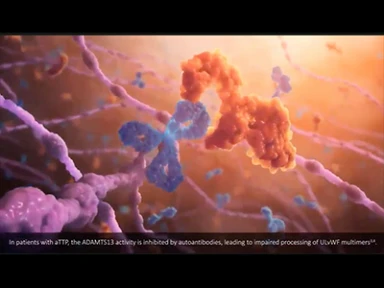Monitoring Ttp
TTP is a life-threatening thrombotic microangiopathy (TMA) that requires quick diagnosis and urgent treatment. 1,2
The prognosis of thrombotic thrombocytopenic purpura (TTP) can be unpredictable1,2
Patients can experience refractory disease or recurrence of their TTP (exacerbation or relapse), highlighting the need for vigilant monitoring3,4
The risks and effects of TTP extend beyond the first acute events that patients experience.5-7
Here are some of the various ways TTP can affect your patients after diagnosis and treatment.
TTP episode
Even with plasma exchange therapy (PEX), mortality risk persists8-10
acute mortality associated with episodes of aTTP9,10
Refractory TTP
Occurs when patients do not have a clinical response after 5 sessions of PEX. Clinical response is defined as sustained platelet count ≥150 × 109/L and LDH <1.5 times ULN and no clinical evidence of new or progressive organ injury.4
Refractory TTP can indicate poor prognosis for survival3
of aTTP patients experience unpredictable refractoriness
TTP exacerbation
A platelet count decrease after a clinical response and before a clinical remission. A clinical exacerbation is defined as platelet count decrease to <150 × 109/L (with other causes of thrombocytopenia excluded), with or without clinical evidence of new or progressive ischemic organ injury, within 30 days of stopping plasma exchange or anti-vWF therapy.4
TTP exacerbation is a threat to patient recovery
of patients have ≥1 TTP episode within 30 days of stopping plasma exchange*
*Retrospective review of French Reference Centre for TMA registry (N=388).
TTP relapse
A new episode of TTP after achieving clinical remission.† A clinical relapse is defined as platelet count decrease to <150 × 109/L (with other causes of thrombocytopenia ruled out), with or without clinical evidence of new ischemic organ injury and a confirmed documentation of severe ADAMTS13 deficiency.4
ADAMTS13 = a disintegrin and metalloproteinase with a thrombospondin type 1 motif, member 13.
†Clinical remission is defined as sustained clinical response with no plasma exchange and no anti-vWF therapy for ≥30 days or attainment of ADAMTS13 remission.
TTP exacerbation is a threat to patient recovery11
reported relapse rate in studies of TTP7
Monitor patients closely. Make them aware of the potential for recurrence (exacerbation or relapse) and educate on symptoms and triggers so they know to reach out immediately.
ULN=upper limit of normal.
- Scully M, Cataland SR, Peyvandi F, et al; HERCULES Investigators. Caplacizumab treatment for acquired thrombotic thrombocytopenic purpura. N Engl J Med. 2019;380(4):335-346. doi:10.1056/NEJMoa1806311
- Joly BS, Coppo P, Veyradier A. Thrombotic thrombocytopenic purpura. Blood. 2017;129(21):2836-2846. doi:10.1182/blood-2016-10-709857
- Sayani FA, Abrams CS. How I treat refractory thrombotic thrombocytopenic purpura. Blood. 2015;125(25):3860-3867. doi:10.1182/blood-2014-11-551580
- Cuker A, Cataland SR, Coppo P, et al; International Working Group for Thrombotic Thrombocytopenic Purpura. Redefining outcomes in immune TTP: an international working group consensus report. Blood. 2021;137(14):1855-1861. doi:10.1182/blood.2020009150
- Han B, Page EE, Stewart LM, et al. Depression and cognitive impairment following recovery from thrombotic thrombocytopenic purpura. Am J Hematol. 2015;90(8):709-714. doi:10.1002/ajh.24060
- Deford CC, Reese JA, Schwartz LH, et al. Multiple major morbidities and increased mortality during long-term follow-up after recovery from thrombotic thrombocytopenic purpura. Blood. 2013;122(12):2023-2029. doi:10.1182/blood-2013-04-496752
- Thejeel B, Garg AX, Clark WF, et al. Long-term outcomes of thrombotic microangiopathy treated with plasma exchange: a systematic review. Am J Hematol. 2016;91(6):626-630. doi:10.1002/ajh.24339
- Goel R, King KE, Takemoto CM, Ness PM, Tobian AAR. Prognostic risk-stratified score for predicting mortality in hospitalized patients with thrombotic thrombocytopenic purpura: nationally representative data from 2007 to 2012. Transfusion. 2016;56(6):1451-1458. doi:10.1111/trf.13586
- Kremer Hovinga JA, Vesely SK, Terrell DR, Lämmle B, George JN. Survival and relapse in patients with thrombotic thrombocytopenic purpura. Blood. 2010;115(8):1500-1511. doi:10.1182/blood-2009-09-243790
- Peyvandi F, Scully M, Kremer Hovinga JA, et al. Caplacizumab reduces the frequency of major thromboembolic events, exacerbations and death in patients with acquired thrombotic thrombocytopenic purpura. J Thromb Haemost. 2017;15(7):1448-1452. doi:10.1111/jth.13716
- Grall M, Azoulay E, Galicier L, et al. Thrombotic thrombocytopenic purpura misdiagnosed as autoimmune cytopenia: causes of diagnostic errors and consequence on outcome. Experience of the French Thrombotic Microangiopathies Reference Centre. Am J Hematol. 2017;92(4):381-387. doi:10.1002/ajh.24665
The long-term impact of thrombotic thrombocytopenic purpura (TTP)
Patients can experience the effects of TTP long after their first episodes
The consequences of TTP can lead to many long-term complications and health risks. Approaching TTP with a long-term mindset can help ensure comprehensive care for your patients.1-3
 Microthrombi may result in long-term neurocognitive decline in patients with TTP1
Microthrombi may result in long-term neurocognitive decline in patients with TTP1
63% of patients with TTP have neurological signs and symptoms during their first event, including2-4
- Coma
- Focal neurological signs
- Personality changes
- Transient ischemic attack
- Seizures
- Stroke
In these patients, studies have shown4
Persistent neurological impairment during remission (49%)
- Disorientation
- Loss of concentration
- Dizziness
- Lack of balance
- Headache
- Diplopia
Significant impairment in memory domains
(direct, backward, and deferred memory) vs the general population
Higher prevalence of relapse in TTP
vs those without neurological symptoms (41% vs 8%)
 Patients with TTP may have increased risk of stroke after recovery5
Patients with TTP may have increased risk of stroke after recovery5
Stroke during the median observation follow-up period (3.08 years) after recovery from TTP occurred in 13.1% of patients, which is five-fold higher than the expected prevalence from an age- and sex-matched reference population.
Stroke risk is common after recovery from TTP and is associated with ADAMTS13 levels
ADAMTS13=a disintegrin and metalloproteinase with thrombospondin type 1 motif, 13.
Low ADAMTS13 activity after recovery from an acute episode is associated with an increased risk of ischemic stroke during the follow-up period (P=0.007).
 of patients with >70% ADAMTS13 levels experienced stroke (0/22)
of patients with >70% ADAMTS13 levels experienced stroke (0/22)
 of patients with >70% ADAMTS13 levels experienced stroke (0/22)
of patients with >70% ADAMTS13 levels experienced stroke (0/22)
 Patients with TTP reported decreased quality of life1,4
Patients with TTP reported decreased quality of life1,4
TTP affects patients’ quality of life over the long term, owing to exacerbations, relapses, and sustained neurocognitive defects. Patients’ responses across health-related quality of life measures suggest that living with TTP is a considerable emotional burden.
Clinical anxiety and depression are serious risks for patients with TTP4
 of patients with >70% ADAMTS13 levels experienced stroke (0/22)
of patients with >70% ADAMTS13 levels experienced stroke (0/22)
 of patients with >70% ADAMTS13 levels experienced stroke (0/22)
of patients with >70% ADAMTS13 levels experienced stroke (0/22)
It’s important to monitor the physical and mental health of your patients with TTP.1,4,5
- Zheng XL, Vesely SK, Cataland SR, et al. ISTH guidelines for the diagnosis of thrombotic thrombocytopenic purpura. J Thromb Haemost. 2020;18(10):2486-2495. doi:10.1111/jth.15006
- Han B, Page EE, Stewart LM, et al. Depression and cognitive impairment following recovery from thrombotic thrombocytopenic purpura. Am J Hematol. 2015;90(8):709-714. doi:10.1002/ajh.24060
- Deford CC, Reese JA, Schwartz LH, et al. Multiple major morbidities and increased mortality during long-term follow-up after recovery from thrombotic thrombocytopenic purpura. Blood. 2013;122(12):2023-2029. doi:10.1182/blood-2013-04-496752
- Riva S, Mancini I, Maino A, et al. Long-term neuropsychological sequelae, emotional wellbeing and quality of life in patients with acquired thrombotic thrombocytopenic purpura. Haematologica. 2020;105(7):1957-1962. doi:10.3324/haematol.2019.226423
- Upreti H, Kasmani J, Dane K, et al. Reduced ADAMTS13 activity during TTP remission is associated with stroke in TTP survivors. Blood. 2019;134(13):1037-1045. doi:10.1182/blood.2019001056

.jpg/jcr:content/athe%20banner1%20(18).jpg)


